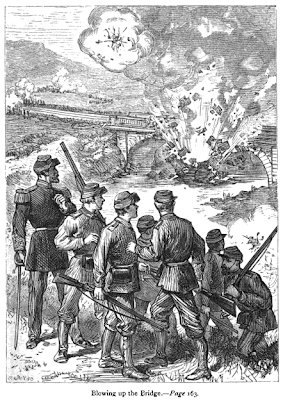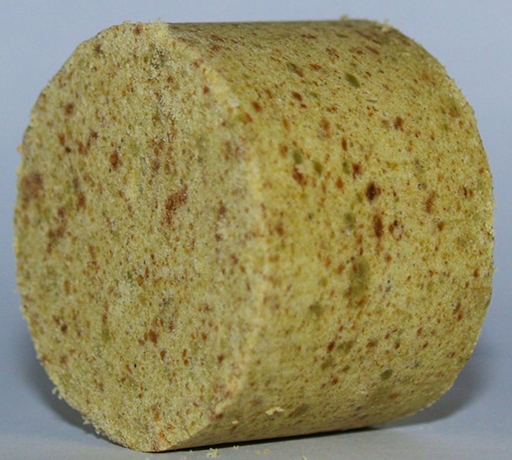
When the Franco-Prussian War broke out in 1870, Prussia struggled to feed its soldiers. Previously, it served them pea soup and bread. But soup is messy, and bread quickly becomes moldy. The Prussian army needed rations that were tasty, satisfying and convenient.
The Prussian state turned to Heinrich Grueneberg for a solution. In 1867 Grueneberg invented the “Erbswurst,” a sausage made from dried bacon and pea flour that could be quickly rehydrated in a mess tin. The Erbswurst proved the perfect food for the Prussian army, as it was tasty and keep well under the worst conditions. The Prussians built a large factory, which employed 1200 people, for making the sausage. The Erbswurst factory produced 5,000 tons of “sausage” during the war.
Perhaps the Erbswurst helped the Prussians defeat the French. It certainly proved popular: In 1899, Knorr purchased the license for the recipe. It continues the production of the Erbswurst to the present day.

Finding Erbswurst in the United States might be a challenge. But you can approximate the taste by making a hearty split pea soup. Here’s a fantastic recipe from Saveur, via The Bitten Word:
German Split Pea Soup (Erbsensuppe)
2 tbsp. extra-virgin olive oil
2 slices bacon, finely chopped
1 large onion, finely chopped
1 rib celery, finely chopped
1 large carrot, peeled and finely chopped
1 small celery root, peeled and finely chopped
Kosher salt, to taste
2 tbsp. flour
10 sprigs flat-leaf parsley
8 sprigs fresh thyme
2 bay leaves
1 lb. green split peas, rinsed and drained
2 large smoked ham hocks (about 2 lbs. total)
Fresh black pepper, to taste
Directions:
Place oil and bacon in a 6-qt. pot and cook over medium-high heat until crisp, about 6 minutes. Transfer bacon to paper towel with a slotted spoon; set aside. Add onions, celery, carrots, and celery root, season with salt, and cook, stirring occasionally, until soft, about 10 minutes. Stir in flour; cook for 3 minutes.
Tie parsley, thyme, and bay leaves together with kitchen twine; add to pot with peas, ham hocks, and 7 cups water. Bring to a boil over high heat. Reduce heat and simmer, covered, until peas are very tender, about 1 hour. Remove from heat. Discard herbs. Transfer hocks to a plate to let cool; pull off and chop the meat; discard fat, skin, and bones. Stir meat into soup, season with salt and pepper, and ladle soup into bowls. Sprinkle with reserved bacon and ground pepper.
Serve with a sour rye bread and butter.

Would you rather receive The Austerity Kitchen by email? Then sign up for my Substack.
And, if you’d like to help the Kitchen keep cookin’, please consider picking up copies of my books, Why Fast? and Fermented Foods.

Your soup sounds pretty good. I can speak to Erbswurst from experience. It will keep body and soul together, and perhaps serves for a single meal if there is some sort of breadstuff to accompany it. Eaten throughout the day it – and you – are offensive. Even the “Erbsensuppe” of the Wehrmacht and Bundeswehr was tastier, more nourishing and less challenging to the digestion.
Erbswurst, you should know, was never meant to be a regular part of the Prussian soldier's daily ration. It was part of his Eisernportion, or “Iron Ration,” not to be eaten except in extremis and on the order of an officer. Most armies of the time – through WWII – had some sort of emergency ration and similar conditions attached to its use. It was withdrawn from issue early during WWI due to soldier complaint, though it continued to be sold.
Horace Kephart has some things to say of Erbswurst in his book “Camping and Woodcraft,” the chapter entitled “Concentrated Foods:”
It never spoils, never gets any “punkier” than it was at the beginning. The stick of erbswurst that you left undetected last year in the seventh pocket of your hunting coat will be just as good when you discover it again this year. Mice won't gnaw it; bugs can't get at it; moisture can't get into it. I have used rolls that had lain so long in damp places that they were all moldy outside, yet the food within was neither worse nor better than before.
A pound of erbswurst, costing from thirty-two to forty cents, is about all a man can eat in three meals straight. Cheap enough, and compact enough, God wot! However, this little boon has a string attached. Erbswurst tastes pretty good to a hungry man in the woods as a hot noonday snack, now and then. It is not appetizing as a sole mainstay for supper on the same day. Next morning, supposing you have missed connections with camp, and have nothing but the rest of that erbswurst, you will down it amid storms and tempests of your own raising. And thenceforth, no matter what fleshpots you may fall upon, you will taste “dynamite soup” for a week.
In its native land, this iron ration lost its popularity and was thrown out of the German army. Over here, we benighted wights keep on using it, or its American similitude, in emergencies, simply because we know of no better substitute, or because it is the easiest thing of the kind to be found on the market. We all wish to discover a ready-made ration as light and compact as erbswurst, as incorruptible and cheap, but one that would be fairly savory at the second and third eating, and polite to our insides (which “dynamite soup” is not).
LikeLike
Thank you for this comment! I did not know that Erbswurst was only to be eaten under the worst conditions. And thanks for citing the passage from Kephart — I'll have to check his book out.
LikeLike
Excerpt from “The Ascent of Denali” the first successful climb of North America's tallest mountain:
“Our prime concern at this camp was the gathering and preserving of a sufficient meat supply for our subsistence on the mountain. It was an easy task. First Karstens killed a caribou and then Walter a mountain-sheep. Then Esaias happened into the midst of a herd of caribou as he climbed over a ridge, and killed three. That was all we needed. Then we went to work preparing the meat. Why should any one haul canned pemmican hundreds of miles into the greatest game country in the world? We made our own pemmican of the choice parts of this tender, juicy meat and we never lost appetite for it or failed to enjoy and assimilate it. A fifty-pound lard-can, three parts filled with water, was set on the stove and kept supplied with joints of meat. As a batch was cooked we took it out and put more into the same water, removed the flesh from the bones, and minced it. Then we melted a can of butter, added pepper and salt to it, and rolled a handful of the minced meat in the butter and molded it with the hands into a ball about as large as a baseball. We made a couple of hundred of such balls and froze them, and they kept perfectly. [Pg 20] When all the boiling was done we put in the hocks of the animals and boiled down the liquor into five pounds of the thickest, richest meat-extract jelly, adding the marrow from the bones. With this pemmican and this extract of caribou, a package of erbswurst and a cupful of rice, we concocted every night the stew which was our main food in the higher regions.”
LikeLike
Hi there from Germany.
Bad news for the Erbswurst front.
Knorr, that means Unilever, decided to stop producing the Erbswurst to December 31st 2018 because of too low request.
Reenactors here are upset about it even hikers, campers and hunters.
I’m glad that I’ve a recipe for Erbswurst which is like the original recipe. The actual sold ones are full of artificial aromas, preservatives and so on, so couldn’t say anymore it is the real one and tastes different.
It’s true that it was only an emergency food, allowed only to be eaten by an order of the commanding officer, in situations when you were cut from your lines, the field kitchens or you were operating behind enemy lines without contact to your own troops.
But it’s still sad that this product disappeares from the market after 129 years of production.
LikeLike